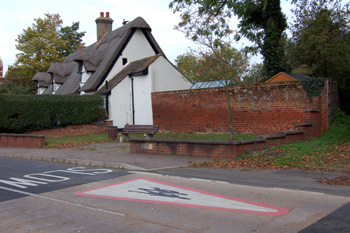Pound Cottage - 53 and 55 High Street Great Barford

Pound Cottage - 55 High Street March 2010
53 and 55 High Street, now called Pound Cottage, was originally a farmhouse, known as Pound Farm, later converted into two small cottages. It was listed by the former Department of Environment in August 1983 as Grade II, of special interest. The department dated the building to the 17th century. It is built of colour washed roughcast over a timber frame and is thatched. The house originally had two rooms downstairs and comprised a single storey with attics. It was extended in 1978 and 1979 to the north to form an L-shaped dwelling.
A deed of 1755 [P23/25/1-2] has a note of land bordering land of Pound Farm. In 1821 the farm was owned by Benjamin Jefferies of Great Barford and John Alders of Buckden [Huntingdonshire]. A valuation of the buildings and timber survives [X290/42]. A transcript, with the original spellings, is as follows:
"The above mentioned Buildings, Fruit Trees, Timber, Fences, Gates and Hedge Fences were examined and Apprais’d at the Sum of Three Hundred and three pounds, Four Shillings this twenty seventh day of July, One Thousand eight hundred and twenty one and equally divided.
To Mr. Jefferiys
- House
- Wood Barn by the Pump
- Pump
- Front fence and gates to the Stable
- Cart Shead
- Old Shead including the Shead
- Garden Fence and gates
- Fruit Trees in the Orchard and Garden
- In the Rick Yard two Leading hovels
- Fence and Gates to the Rick Yard
- Home Close Half share of hedge Fence and Gates
- Fishers Close Nine Trees, 63 Spins, 6 Pollards
Half share of hedge Fence and Gates
To Mr. Alders
- Breach or Bean Barn
- Fence and Gate extending from the Breach Barn to the House
- Wheat Barn
- Cow Lodge
- Stable and Pigstye
- Fence adjoining the Pigstye
- Granary
- Mill Feild Six spins and hedge
- Teels Corner Eight Pollards
- East End Brook Fourteen Spins, 9 Pollards
- Great Meadow One Tree, 13 Spins, 6 Pollards
- Home Close Fifteen Trees, 19 Spins, 6 Pollards
- Fishers Close Twenty eight Trees, 86 Spins, 8 Pollards
N. B. As Teal’s Corner 70 Pole of Live Hedge gone, the whole value £3/10/- to be accounted for with the Timber sold by Mr. Jefferiys.
Having allowed in the Home Close 2 Elm Trees as compensation in Part of Buildings a Cart hovel as New recent Agreement by Mr. Jefferiys and Mr. Alders".
A spinney, as well as being a plantation of trees was also a clump of thorns or brambles. Perhaps the spins referred to here were some form of bramble, maybe blackberry bushes
The Rating and Valuation Act 1925 specified that every building and piece of land in the country was to be assessed to determine its rateable value. Most of Bedfordshire was valued in 1927 and the valuer visiting 53 and 55 High Street [DV1/C56/22-23] found two identical dwellings, both owned by F. W. Davison, who also owned College Farm, Green End Farm and Creakers. Number 53 was occupied by Albert Reynolds, 55 by Alfred William Myers. Reynolds paid £3/10/- and Myers £5 per year in rent.
Both houses comprised a living room with a range downstairs with two small bedrooms in the attics above. A coal and wood barn and a privy stood outside each.
The building was named Pound Farm and is named Pound Cottage after the pound which stood nearby. Pounds were enclosed spaces used to keep the animals (impounded) of manorial tenants which had strayed from their owners’ holdings. A fine was charged to recover the animals in question.
The Bedfordshire Historic Environment Record [HER] contains information on the county’s historic buildings and landscapes and summaries of each entry can now be found online as part of the Heritage Gateway website. The entry for the pound [HER 5712] notes that it was a 17th or 18th century red brick building.
In the 1930s Bedfordshire Historical Records Society carried out a survey of ancient buildings in the county. Volume III, of 1936, was devoted to pounds and turnpikes. The section on pounds was written by J. Steele Elliott who wrote this of Great Barford: “In the year 1706 ‘The Farm by the Pound’ is referred to in some notes written at the end of the Church register; and again in the same volume in a Terrier of land belonging to the Vicarage. ‘Pound Farm’ is named; ‘Pound Close’ and ‘Pound Farm’ are mentioned in the [Inclosure] Award of 1824. The Pound stood on the east side of the highway near the Vicarage, midway between the cross-roads and the river. The School was built on the site of ‘Pound Farm’ and the land merged into ‘College farm’. The three brick sides of the Pound still remain in situ, the oak-paled front and gate removed about 1882. One of the last charges was for a sow impounded two days, at a cost to the owner of 1s.”.
 The pound October 2010
The pound October 2010